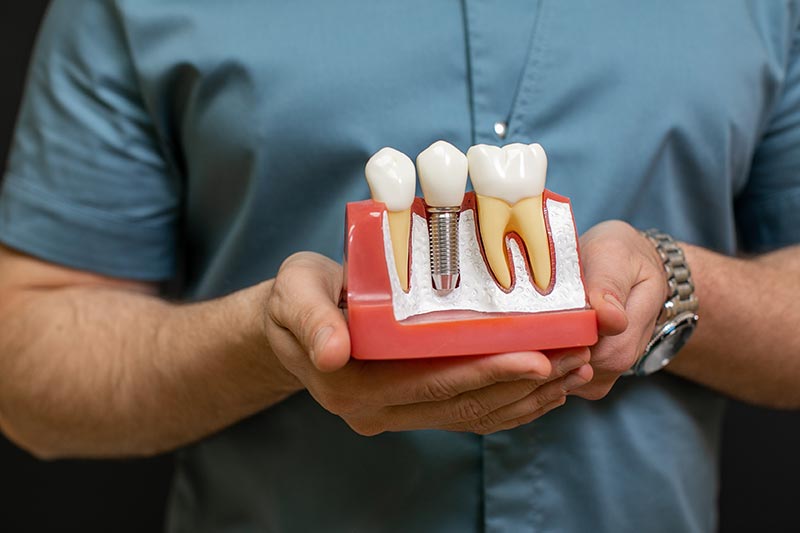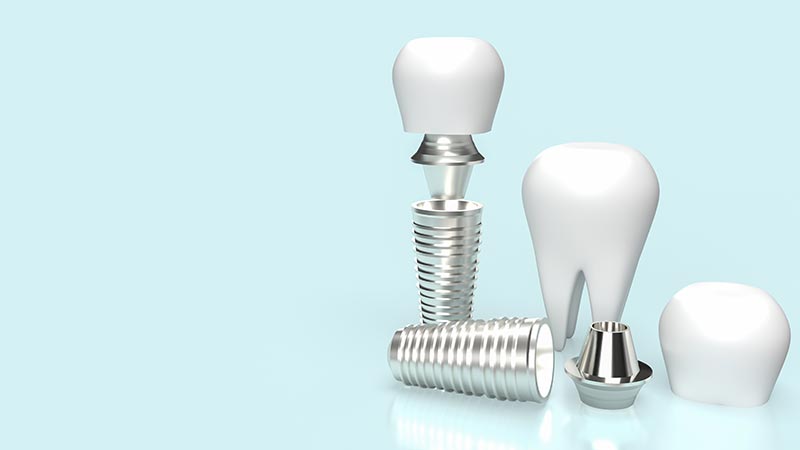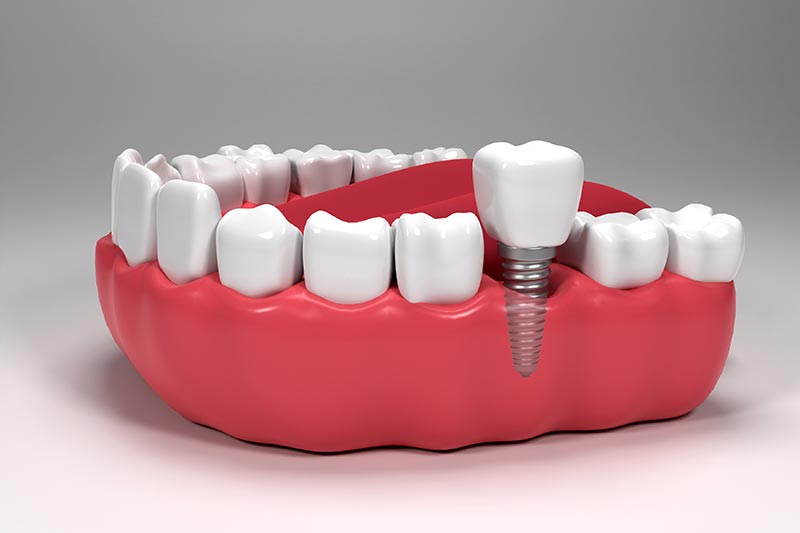
Dental implants can be defined as artificial structures that mimic the roots of natural teeth. They are typically made of titanium or titanium alloys and are surgically implanted into the jawbone. This procedure aims to provide a permanent solution for replacing missing teeth and is an aesthetically pleasing, functional alternative.
The basic components of dental implants are:
- Implant screw (device): It is the structure that is inserted into the jawbone and forms the basis for the denture. It is preferred due to its longevity, durability, and biocompatibility.
- Abutment: It serves as a connection between the implant screw and the upper prosthesis (crown, bridge or denture).
- Prosthesis (crown): The part that imitates the missing tooth and provides visual and functional features.
Dental Implant treatment often offers a solution to the following complaints:
- Replacing one or more missing or lost teeth.
- Creating an alternative to bridges or removable dentures without damaging natural teeth.
- Ensures better chewing function and speech intelligibility.
- Improvement of oral health and aesthetic appearance.
The benefits of dental implants include longevity, a natural appearance, and the prevention of damage to other teeth. Furthermore, they help maintain jaw health by preventing bone loss.
Because dental implant treatment is a surgical procedure, careful assessment and planning are required. Factors that influence treatment success include adequate jawbone density and general oral health. Therefore, it is crucial to develop an individualized treatment plan through a comprehensive examination.
How does a dental implant work? Drive mechanism
To understand the functional mechanism of dental implants, it is first necessary to examine the basic building blocks of this procedure. During implant treatment, we replace missing teeth with small structures made of biocompatible materials such as titanium or zirconium. These structures integrate into the jawbone and mimic the missing tooth root.
The most important steps in implantation can be listed as follows:
- Examination and planning: First, we conduct a detailed assessment of the patient’s tooth structure and general health. We use X-rays or three-dimensional imaging techniques to assess the jawbone structure. During this phase, it is very important to inform the patient about the expected results and risks.
- Surgical placement: We typically place the implant into the jawbone under local anesthesia. The screw-shaped implant, made of titanium or zirconium, is carefully inserted into the prepared socket. We use very gentle techniques to avoid damaging the surrounding tissue during the surgical procedure.
- Osteointegration process: Typically, you have to wait several months for the implant to fuse with the jawbone. This process creates a strong bond between the implant and the jawbone, mimicking a natural tooth root. This mechanism makes dental implants extremely durable.
- Prosthesis placement: Once osteointegration is complete, we attach the final denture to the implant. This prosthesis delivers results that most closely resemble the appearance and function of natural teeth. We work with the utmost care to achieve perfect harmony between aesthetics and functionality.
Thanks to this functional mechanism of the dental implant, we offer both aesthetically and functionally successful solutions to replace missing teeth. Thanks to the biotechnological methods used at every stage, implant treatments become a long-lasting and reliable option.
What are the advantages of dental implants?
Dental implants are one of the most effective and permanent solutions in modern dentistry. Their natural appearance and functionality make them an excellent alternative for replacing lost teeth. When evaluating the benefits of dental implants, we focus on their contribution to both aesthetics and health.
Aesthetic and natural appearance
Dental implants precisely mimic your natural teeth. They give your smile a natural aesthetic by adjusting color and shape. They are preferred because they offer a longer-lasting and more realistic appearance compared to other treatment options.
Better chewing and more comfort
Unlike traditional dentures, implants are attached to the jawbone. This prevents you from slipping or experiencing discomfort while eating or speaking. Dental implants allow you to chew like your natural teeth, so your eating habits are preserved.
Maintaining jawbone health
Tooth loss can lead to a weakening of the jawbone over time. However, because implants are integrated into the jawbone, they stimulate the bone and prevent resorption. This allows us to maintain long-term jawbone health.
Does not damage neighboring teeth
For bridges or similar treatments, it’s often necessary to change the shape of the neighboring teeth. However, with dental implants, such a procedure is unnecessary. The treatment is performed without touching your neighboring teeth.
Long-lasting solution
Dental implants offer a lifelong solution with proper care. Although they may seem expensive compared to other dental treatment options, they are more advantageous in the long run in terms of strength and durability.
Thanks to modern dental technology, dental implants are an indispensable treatment option, both aesthetically and functionally. In addition to the additional health and comfort benefits, implants make an important contribution to improving our quality of life.
Who is suitable for dental implants?
Dental implant treatment is a method commonly used to provide aesthetic and functional solutions for missing teeth. However, not everyone is a suitable candidate for dental implants. Several important factors are considered when identifying suitable candidates. We must carefully consider each of these factors.
Healthy mouth and jaw structure
One of the basic requirements for the success of dental implants is that the jawbone has sufficient density and health to support the implant. Individuals with incomplete bone development or patients with jawbone loss may require additional treatment prior to implantation. In these cases, bone grafting or sinus lift procedures may be performed.
General health
The patient’s general health plays a crucial role in planning dental implant treatment. For individuals with systemic diseases (such as uncontrolled diabetes, immune system problems, or cardiovascular problems), the treatment plan should be carefully reviewed. Furthermore, smoking can negatively impact the healing process, and this should be taken into account.
People who care about oral hygiene
The long-term success of implant treatment depends directly on the patient’s ability to maintain oral hygiene. Regular brushing, flossing, and regular dental checkups are essential during this process.
People with missing teeth
The main candidates are people who are missing teeth and are looking for an alternative to traditional denture solutions. Patients who have aesthetic concerns or are looking for a permanent solution that resembles natural teeth prefer implant treatment.
Pregnancy and some temporary situations
Pregnant women, implantation is generally postponed until after birth. Patients with gingivitis or other temporary oral health problems should also be treated first.
It is important to emphasize that each individual must be assessed individually, taking into account the above criteria. Making decisions based on these factors under the guidance of a dentist will result in more effective and successful results in implant treatment.












